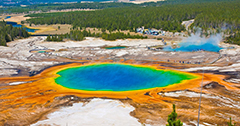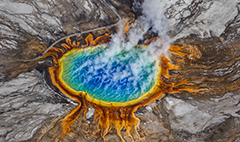Yellowstone Eruption Disaster
The last full-scale eruption of the Yellowstone Supervolcano, the Lava Creek eruption which happened approximately 640,000 years ago, ejected approximately 240 cubic miles (1,000 km3) of rock, dust and volcanic ash into the sky. Geologists are closely monitoring the rise and fall of the Yellowstone Plateau, which has been rising as quickly as 0.6 inches (1.5 cm) per year, as an indication of changes in magma chamber pressure.
 The upward movement of the Yellowstone caldera floor between 2004 and 2008—almost 3 inches (7.6 cm) each year—was more than three times greater than ever observed since such measurements began in 1923. From 2004 to 2008, the land surface within the caldera moved upward as much as 8 inches (20 cm) at the White Lake GPS station. By the end of 2009, the uplift had slowed significantly and appeared to have stopped. In January 2010, the USGS stated that "uplift of the Yellowstone Caldera has slowed significantly" and that uplift continues but at a slower pace.
The upward movement of the Yellowstone caldera floor between 2004 and 2008—almost 3 inches (7.6 cm) each year—was more than three times greater than ever observed since such measurements began in 1923. From 2004 to 2008, the land surface within the caldera moved upward as much as 8 inches (20 cm) at the White Lake GPS station. By the end of 2009, the uplift had slowed significantly and appeared to have stopped. In January 2010, the USGS stated that "uplift of the Yellowstone Caldera has slowed significantly" and that uplift continues but at a slower pace.
The U.S. Geological Survey, University of Utah and National Park Service scientists with the Yellowstone Volcano Observatory maintain that they "see no evidence that another such cataclysmic eruption will occur at Yellowstone in the foreseeable future. Recurrence intervals of these events are neither regular nor predictable." This conclusion was reiterated in December 2013 in the aftermath of the publication of a study by University of Utah scientists finding that the "size of the magma body beneath Yellowstone is significantly larger than had been thought". The Yellowstone Volcano Observatory issued a statement on its website stating,
 Although fascinating, the new findings do not imply increased geologic hazards at Yellowstone, and certainly do not increase the chances of a 'supereruption' in the near future. Contrary to some media reports, Yellowstone is not 'overdue' for a supereruption. Other media reports were more hyperbolic in their coverage.
Although fascinating, the new findings do not imply increased geologic hazards at Yellowstone, and certainly do not increase the chances of a 'supereruption' in the near future. Contrary to some media reports, Yellowstone is not 'overdue' for a supereruption. Other media reports were more hyperbolic in their coverage.
A study published in GSA Today, the monthly news and science magazine of the Geological Society of America, identified three fault zones on which future eruptions are most likely to be centered. Two of those areas are associated with lava flows aged 174,000–70,000 years, and the third is a focus of present-day seismicity.
In 2017, NASA conducted a study to determine the feasibility of preventing the volcano from erupting. The results suggested that cooling the magma chamber by 35 percent would be enough to forestall such an incident. NASA proposed introducing water at high pressure 10 kilometers underground. The circulating water would release heat at the surface, possibly in a way that could be used as a power source. If enacted, the plan would cost about $3.46 billion. Nevertheless, according to Brian Wilson of the Jet Propulsion Laboratory, a completed project might trigger, instead of prevent, an eruption". More details
 The upward movement of the Yellowstone caldera floor between 2004 and 2008—almost 3 inches (7.6 cm) each year—was more than three times greater than ever observed since such measurements began in 1923. From 2004 to 2008, the land surface within the caldera moved upward as much as 8 inches (20 cm) at the White Lake GPS station. By the end of 2009, the uplift had slowed significantly and appeared to have stopped. In January 2010, the USGS stated that "uplift of the Yellowstone Caldera has slowed significantly" and that uplift continues but at a slower pace.
The upward movement of the Yellowstone caldera floor between 2004 and 2008—almost 3 inches (7.6 cm) each year—was more than three times greater than ever observed since such measurements began in 1923. From 2004 to 2008, the land surface within the caldera moved upward as much as 8 inches (20 cm) at the White Lake GPS station. By the end of 2009, the uplift had slowed significantly and appeared to have stopped. In January 2010, the USGS stated that "uplift of the Yellowstone Caldera has slowed significantly" and that uplift continues but at a slower pace. The U.S. Geological Survey, University of Utah and National Park Service scientists with the Yellowstone Volcano Observatory maintain that they "see no evidence that another such cataclysmic eruption will occur at Yellowstone in the foreseeable future. Recurrence intervals of these events are neither regular nor predictable." This conclusion was reiterated in December 2013 in the aftermath of the publication of a study by University of Utah scientists finding that the "size of the magma body beneath Yellowstone is significantly larger than had been thought". The Yellowstone Volcano Observatory issued a statement on its website stating,
 Although fascinating, the new findings do not imply increased geologic hazards at Yellowstone, and certainly do not increase the chances of a 'supereruption' in the near future. Contrary to some media reports, Yellowstone is not 'overdue' for a supereruption. Other media reports were more hyperbolic in their coverage.
Although fascinating, the new findings do not imply increased geologic hazards at Yellowstone, and certainly do not increase the chances of a 'supereruption' in the near future. Contrary to some media reports, Yellowstone is not 'overdue' for a supereruption. Other media reports were more hyperbolic in their coverage.A study published in GSA Today, the monthly news and science magazine of the Geological Society of America, identified three fault zones on which future eruptions are most likely to be centered. Two of those areas are associated with lava flows aged 174,000–70,000 years, and the third is a focus of present-day seismicity.
In 2017, NASA conducted a study to determine the feasibility of preventing the volcano from erupting. The results suggested that cooling the magma chamber by 35 percent would be enough to forestall such an incident. NASA proposed introducing water at high pressure 10 kilometers underground. The circulating water would release heat at the surface, possibly in a way that could be used as a power source. If enacted, the plan would cost about $3.46 billion. Nevertheless, according to Brian Wilson of the Jet Propulsion Laboratory, a completed project might trigger, instead of prevent, an eruption". More details
